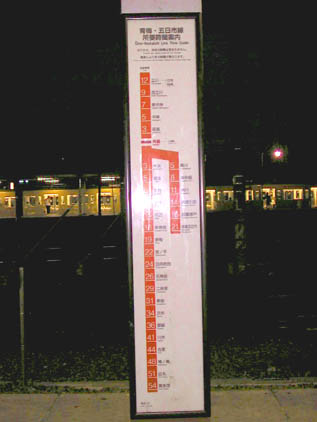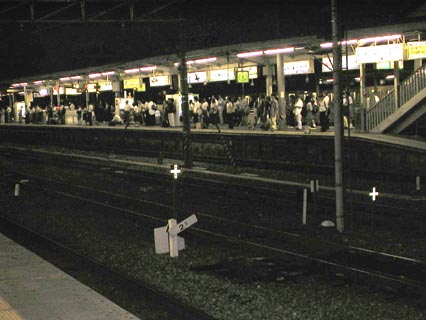3 in 30 - 2000.09.04

A platform sign tells how much time
it takes to get to any station on the line.
The easiest method of getting around Japan for us continues to be by train. Since we cannot read the road signs, if we plan to go any distance, it will be by train. Often parking facilities are quite limited, and those that do exist are rather costly, there would be no place to park once we got somewhere by automobile. We have space in our driveway for one and a half cars, which is much more spacious than 90% of our neighbors. At least half a dozen of our immediate neighbors must rent additional space if they have a car.
At the train station, on the platform are these signs which tell how long it takes to get to the listed stations on the line. The Ome Line runs between Tachikawa at the top of the chart and Okutama at the bottom. Alternately, the train runs out to Itsukaiichi. The red bar near the top is the Haijima station. From Haijima, it is 12 minutes up the line to Tachikawa and 54 minutes down the line to Okutama.

Precise schedules for trains that are mostly precise
The Haijima schedule is a busy one. This board shows two of the schedules. On the left is the schedule for the Hachiko line which runs north and south. In the center is the schedule for the Ome Line heading up toward Tokyo. There are two panels—one for normal workdays Monday through Saturday and one for Sundays and holidays.
Between 7 and 8 AM, sixteen trains go through Haijima on the Ome Line. That's more than one train every four minutes to get commuters to their offices downtown. Most of these trains will have ten cars, holding about 100 people each, so that's about 16,000 people heading east though our station between 7 and 8 AM. We have been told that the busiest train station in the world is the Shijuku station downtown where four million pass through daily.
At the bottom of the board is a diagram of how the trains run and the stops they make. Local trains stop at every stop, thirty-one stations on the way to Tokyo (the bottom line). The second from the top is a limited express, which makes only 13 stops for the same trip. The time difference is about 45 minutes or 55 minutes. It isn't a big difference, but when you are passing stopped train going by the express, you feel like you are at an advantage.

Train station signage is very helpful in getting around
At about 7 PM, there don't seem to be too many people waiting for this train on the Hachiko Line. This line is not a particularly busy one and doesn't run as frequently as the Ome Line. You can see part of the schedule on the above board.
This train stops a little closer to one of the gates on the base, so it is the line we sometimes take to get to and from work and school. It helps to pay attention to the schedule because if you miss a train, you will likely wait another half an hour for the next one. Either that, or take the Ome line to a station further away from the gate. If you have just missed a train, you can get to the gate before the next train comes by, even though you have to walk an extra kilometer.
Some of the lighted signs on the platform are advertisements and a few others tell what station it is. There are other signs posted on the poles telling the station. The stations are announced on the train by the conductor, but through the speaker system, it isn't always audible. Being able to see and read the signs is helpful.